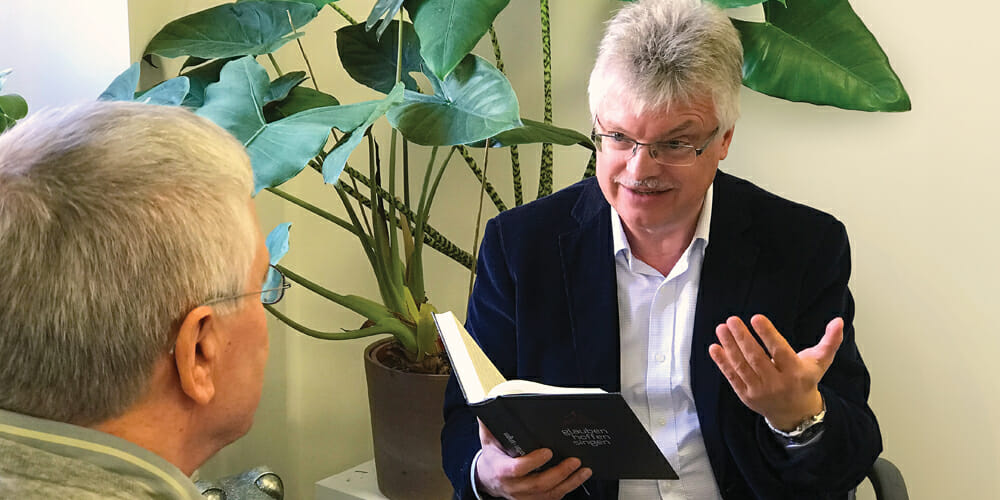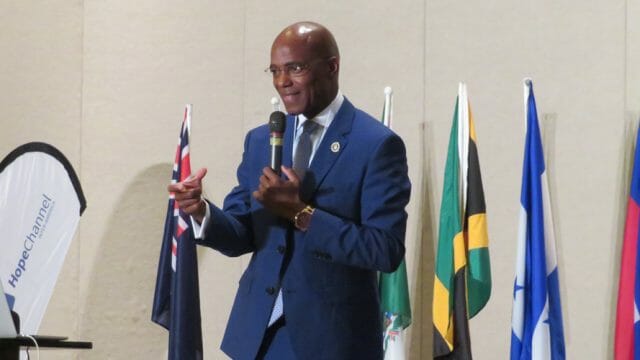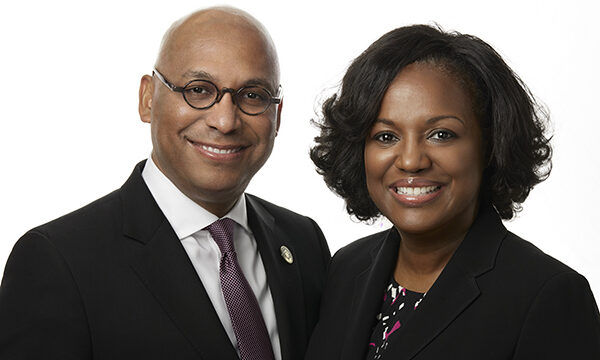A conversation about the publication of the new German-language hymnal

Adventist World associate editor Gerald Klingbeil recently spoke to Friedbert Hartmann, secretary of the North German Union Conference located in Hanover, Germany, and chair of the committee that spent years of planning the new hymnal Glauben—Hoffen—Singen, about the process and experiences of introducing a new hymnal.
Music is an important part of worship and church life. The church in Germany and Switzerland had last updated its hymnal in 1983. Why was it important to produce a new hymnal? How often should one revise a hymnal and why?
When we decided in 2007 to start work on a new hymnal, there were several reasons for doing this. First, our hymnal Wir loben Gott (We Praise God) was almost out of print. Second, the licenses for the songs were about to expire; we could not just reprint. Third, many churches had collections of more youthful gospel songs, which led us to publish in 2004 a supplementary hymnal with newer tunes called Leben aus der Quelle (Life From the Source). This meant that Adventist churches in Germany sang from two hymnals. We wanted to address this situation.
Consequently, we felt it was important to create one hymnal that included traditional hymns but also newer songs. We even had a greater objective: the new hymnal should incorporate hymns for each generation, including children and adolescents, and even for church members who came from other countries to Germany and Switzerland, so that they could at least find a few of their own familiar hymns. Our concept was to create an integrative hymnal.
You chaired the committee that produced the new hymnal. How long did the process take, and how did it work?
The first meeting of the working committee took place on October 11, 2007. We soon decided to work with two committees: one committee dealing with musical issues, the other with theological-linguistic ones. We also conducted an Internet-based survey among church members. Then we reviewed and rated each hymn from the old hymnal. We even reviewed older Adventist and international hymnals for songs that might fit into the new hymnal, and also received a variety of suggestions for hymns. A number of Adventist composers submitted their own music. The result was a pool of music with several thousand hymns. All songs were musically, linguistically, and theologically evaluated. We wanted to include in the new hymnal only songs that not only were of a high musical and literary quality, but would also theologically express what Adventists stand for. Then, at some point we had to make a selection. Our hymnal ended up containing 694 songs.
Twenty-two people were part of the two working committees: professional musicians, hymnologists, pastors, specialists in German linguistics, laypeople, theologians, educators—all members of our church in Germany and Switzerland.
My family and I often sing from the new hymnal. While we miss some songs from the older hymnals, we are also excited to learn new ones. Which criteria were important for you in the selection of the hymns?
We wanted to create an integrative hymnal; anyone who is part of the Adventist Church in German-speaking countries should be able to find “his” or “her” songs. We structured the new hymnal into eight main thematic categories and 48 subcategories, starting with praise, gratitude, and worship, and ending with God completing His work on earth. All topics concerning our walk of life and faith are reflected in the hymns. Where possible, we have included hymns from older Adventist traditions in each main category, as well as new songs written in recent years. These songs can be found side by side in the hymnal. I confess that I am missing some older hymns, which I found particularly beautiful. But the choices were not made by individuals but by two committees working jointly together.
What was your experience with the introduction of the new hymnal in the churches? I can imagine that not all church members were happy.
Our experience has varied greatly: While many churches were looking forward to the new hymnal, there were some churches and church members who had reservations. We realized that it is always difficult to replace something that has been part of us for decades. Putting away the familiar and engaging with a new hymnal, with an unfamiliar title and a partially new organization as well as new songs, can be quite challenging. We are very happy that the vast majority of Adventist churches in Germany and Switzerland now enjoy singing from the new hymnal. The demand for our new hymnal is so great that we will soon have to reprint it.
We also have noticed that there was an easier acceptance of the new hymnal in places where it was formally presented, explained, and introduced. A hymnal (which will probably accompany us again for decades) needs to be discovered.
There are also churches that still use the old hymnal. This is good. After all, it is not about the right or the wrong hymnal, but about the content: praising and worshipping God, singing in order to testify to our faith, and, not least, to experience God and fellowship with each other through singing.
What kind of feedback did you get from musicians and hymnologists?
This hymnal was well received by these experts. The integrative approach and the thematic division of the book, which are based on our life and faith experience, are appreciated. They also liked the fact that traditional hymns stand next to worship songs, that children’s and foreign-language songs have been included in the hymnal, and that the hymnal not only contains songs but also many texts and suggestions for the worship service. Many find it remarkable that we have printed almost all songs in four voices and even included chords for guitar and keyboard players. We realize that many organ players in the church are struggling to accompany the more youthful songs. For that reason, we are offering seminars in which one can learn to accompany such songs.
What experiences have you had that would be of interest to other regions of the world church that are planning a new hymnal? What did you learn? Would you do something different if you had to do it over?
For the first time, we involved a theological-linguistic working committee. Up to now, musicians generally produced a new hymnal. But it has been worthwhile to take a closer look at the lyrics and especially at the correct theology in the texts.
We also learned that producing a hymnal takes much longer than we thought. Our advice: Start well ahead of time!
We have developed the hymnal with the help of 22 people. For most of what we did we involved all participants. Next time we would consider whether some tasks could be worked on by a smaller group. The more tasks that have to be processed by all committee members, the longer it takes.
We had also planned additional materials for the new hymnal. For example: additional accompaniment sets for brass bands or for three-part vocal ensembles. We even dreamed of a computer app. All of this, however, requires human and financial resources. We did not have enough of both to turn all our plans into reality. Therefore, our advice for others would be: plan and budget from the outset all the additional materials that are important for a new hymnal. And if it is not possible to do everything, then start prioritizing. This is what we did, and we are grateful that God has blessed us and that our Adventist churches can sing from a new hymnal, proclaim God’s love, and experience fellowship with each other through singing.








